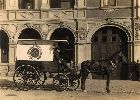Multimedia Content

The St. John Ambulance Association, horse and covered cart outside the Eastern Hill Fire Station, c. 1901, courtesy of State Library of Victoria.
Details
Ambulance Services
The Metropolitan Ambulance Service provides emergency ambulance teams, pre-hospital care and non-emergency stretcher and clinic car transport services across a service area of nearly 10 000 sq km, including Greater Melbourne and its peripheral rural communities. Before the rise of organised ambulance services in the 1880s, the sick and injured were transported to hospital by stretcher or cab, sometimes carried on a door, or by any other available means of transport. Where once the workmates of injured 19th century workers would convey casualties to the porter at the Royal Melbourne Hospital in Lonsdale Street, the professionalisation of ambulance services in the 20th century ensured speedy and trained patient care. As with the decline of public viewings at the morgue, inquests in hotels, and the keeping of the deceased at home before burial, such a transformation marked an increased separation of city-dwellers from the day-to-day experience of mortality.
In 1880 and 1881, St Kilda doctor Robert Robertson, a former surgeon at the Melbourne Hospital, gave a series of public lectures to the St Kilda Volunteer Corps on military first aid and the treatment of accident victims. While Robertson became surgeon-colonel of the newly formed Victorian Militia Ambulance Corps, the first Australian branch of the St John Ambulance Association was formed in Melbourne in mid-1883, on the initiative of forensic pathologist Dr James Edward Neild, former secretary of the Medical Society of Victoria (1862-79), and later Deputy Coroner (from 1891). The St John Ambulance Association had developed from the British Order of St John (1831), which in turn was descended from the Knights Hospitaller, a medieval order of military monks. In Melbourne, the society's rules were adopted and council appointed, chaired by actor and politician George Coppin, at a public meeting in the Athenaeum Hall on 26 June 1883. Landowner and philanthropist Sir William Clarke was invited to become first president. The Victorian centre carried on the work of running classes, raising public awareness of first aid, and instructing school students, police, railway staff and fire brigade officers on the preliminary treatment of the sick and injured.
By 1889 six Ashford litters (two-wheeled stretchers) had been purchased with a donation from Lady Janet Clarke, wife of the Association's president, and placed in police stations linked by telephone. A decade later, an Ashford litter with trained assistants operated out of the Metropolitan Fire Brigade station at Eastern Hill. A horse-drawn ambulance borrowed from the Defence Department operated out of the fire station in 1899, and the Association purchased its own vehicle the following year. By 1910, the ambulance transport service had branches in the city, South Yarra and Ascot Vale.
After a period of operation by private contract - when the service was variously run out of an ice works near Queens Bridge and a building in Lang Lane off Bourke Street behind the Grand (Windsor) Hotel - the St John Association resumed control of the service, with Harry Osgood-Cannon appointed chief officer. The first motorised ambulance began operation in 1910. By 1916 financial difficulties forced the Association to divorce its first-aid training role from that of patient transport, leading to the formation of the Victorian Civil Ambulance Service, which ran as a not-for-profit company until 1936 when it became an incorporated body under the Hospitals and Charities Act.
The St John Association continued to provide first-aid support at major accident, sporting and public events, as it had done from the time of the 1908 Sunshine rail disaster, the visit of the Great White Fleet, and the outbreak of disease during the 1919 influenza epidemic. Such involvement has been recognised over the course of the 20th century at royal visits, the Sunbury Pop Festival, St Patrick's Day processions, Anzac Day parades, Melbourne Cup and AFL Grand Final days.
A range of technological and organisational advances in the second half of the 20th century streamlined and professionalised Melbourne's ambulance services: two-way radios (1954); air ambulance (1962); Mobile Intensive Care Ambulance (1971); and degree courses for ambulance officers (1978). In 1993 the Victorian Government opened ambulance transport services to competition, and Computer Aided Dispatch and Automatic Vehicle Location Systems were introduced with the commissioning in 1995 of the Intergraph BEST (Victoria) Pty Ltd Communications Centre. A 1997 auditor-general's report into the Metropolitan Ambulance Service followed public criticism of the service's poor response times and financial deficits.
- References
- Howie-Willis, Ian, A century for Australia: St John Ambulance in Australia 1883-1983, Priory of the Order of St John in Australia, Canberra, 1983. Details
